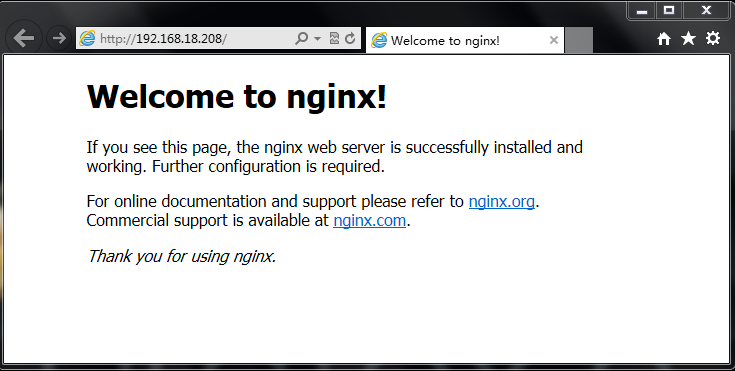
环境准备
1. 操作系统
centos 6.4 x86_64
2.软件版本
nginx 1.4.2
3.实验拓扑
4.安装yum源
[root@nginx ~]# rpm -ivh http://download.fedoraproject.org/pub/epel/6/x86_64/epel-release-6-8.noarch.rpm [root@web1 ~]# rpm -ivh http://download.fedoraproject.org/pub/epel/6/x86_64/epel-release-6-8.noarch.rpm [root@web2 ~]# rpm -ivh http://download.fedoraproject.org/pub/epel/6/x86_64/epel-release-6-8.noarch.rpm
5.各节点时间同步
[root@nginx ~]# ntpdate 202.120.2.101 [root@web1 ~]# ntpdate 202.120.2.101 [root@web2 ~]# ntpdate 202.120.2.101
6.关闭防火墙与selinux
[root@nginx ~]# service iptables stop [root@nginx ~]# chkconfig iptables off [root@nginx ~]# getenforce disabled [root@web1 ~]# service iptables stop [root@web1 ~]# chkconfig iptables off [root@web1 ~]# getenforce disabled [root@web2 ~]# service iptables stop [root@web2 ~]# chkconfig iptables off [root@web2 ~]# getenforce disabled
安装nginx
1.解压
[root@nginx src]# tar xf nginx-1.4.2.tar.gz
2.新建nginx用户与组
[root@nginx src]# groupadd -g 108 -r nginx [root@nginx src]# useradd -u 108 -r -g 108 nginx [root@nginx src]# id nginx uid=108(nginx) gid=108(nginx) 组=108(nginx)
3.准备编译配置文件
[root@nginx src]# yum install -y pcre-devel openssl-devel [root@nginx nginx-1.4.2]# ./configure --prefix=/usr --sbin-path=/usr/sbin/nginx --conf-path=/etc/nginx/nginx.conf --error-log-path=/var/log/nginx/error.log --http-log-path=/var/log/nginx/access.log --pid-path=/var/run/nginx/nginx.pid --lock-path=/var/lock/nginx.lock --user=nginx --group=nginx --with-http_ssl_module --with-http_flv_module --with-http_stub_status_module --with-http_gzip_static_module --http-client-body-temp-path=/var/tmp/nginx/client/ --http-proxy-temp-path=/var/tmp/nginx/proxy/ --http-fastcgi-temp-path=/var/tmp/nginx/fcgi/ --http-uwsgi-temp-path=/var/tmp/nginx/uwsgi --http-scgi-temp-path=/var/tmp/nginx/scgi --with-pcre
4.编译并安装
[root@nginx nginx-1.4.2]# make && make install
5.为nginx提供sysv init脚本
[root@nginx ~]# cat /etc/init.d/nginx
#!/bin/sh
#
# nginx - this script starts and stops the nginx daemon
#
# chkconfig: - 85 15
# description: nginx is an http(s) server, http(s) reverse \
# proxy and imap/pop3 proxy server
# processname: nginx
# config: /etc/nginx/nginx.conf
# config: /etc/sysconfig/nginx
# pidfile: /var/run/nginx.pid
# source function library.
. /etc/rc.d/init.d/functions
# source networking configuration.
. /etc/sysconfig/network
# check that networking is up.
[ "$networking" = "no" ] && exit 0
nginx="/usr/sbin/nginx"
prog=$(basename $nginx)
nginx_conf_file="/etc/nginx/nginx.conf"
[ -f /etc/sysconfig/nginx ] && . /etc/sysconfig/nginx
lockfile=/var/lock/subsys/nginx
make_dirs() {
# make required directories
user=`nginx -v 2>&1 | grep "configure arguments:" | sed 's/[^*]*--user=\([^ ]*\).*/\1/g' -`
options=`$nginx -v 2>&1 | grep 'configure arguments:'`
for opt in $options; do
if [ `echo $opt | grep '.*-temp-path'` ]; then
value=`echo $opt | cut -d "=" -f 2`
if [ ! -d "$value" ]; then
# echo "creating" $value
mkdir -p $value && chown -r $user $value
fi
fi
done
}
start() {
[ -x $nginx ] || exit 5
[ -f $nginx_conf_file ] || exit 6
make_dirs
echo -n $"starting $prog: "
daemon $nginx -c $nginx_conf_file
retval=$?
echo
[ $retval -eq 0 ] && touch $lockfile
return $retval
}
stop() {
echo -n $"stopping $prog: "
killproc $prog -quit
retval=$?
echo
[ $retval -eq 0 ] && rm -f $lockfile
return $retval
}
restart() {
configtest || return $?
stop
sleep 1
start
}
reload() {
configtest || return $?
echo -n $"reloading $prog: "
killproc $nginx -hup
retval=$?
echo
}
force_reload() {
restart
}
configtest() {
$nginx -t -c $nginx_conf_file
}
rh_status() {
status $prog
}
rh_status_q() {
rh_status >/dev/null 2>&1
}
case "$1" in
start)
rh_status_q && exit 0
$1
;;
stop)
rh_status_q || exit 0
$1
;;
restart|configtest)
$1
;;
reload)
rh_status_q || exit 7
$1
;;
force-reload)
force_reload
;;
status)
rh_status
;;
condrestart|try-restart)
rh_status_q || exit 0
;;
*)
echo $"usage: $0 {start|stop|status|restart|condrestart|try-restart|reload|force-reload|configtest}"
exit 2
esac6.为此脚本赋予执行权限
[root@nginx ~]# chmod +x /etc/init.d/nginx
7.添加至服务管理列表,并让其开机自动启动
[root@nginx ~]# chkconfig --add nginx [root@nginx ~]# chkconfig nginx on [root@nginx ~]# chkconfig nginx --list nginx 0:关闭 1:关闭 2:启用 3:启用 4:启用 5:启用 6:关闭
8.启动nginx
[root@nginx ~]# service nginx start 正在启动 nginx: [确定]
9.查看一下端口
[root@nginx ~]# netstat -ntlp | grep :80 tcp 0 0 0.0.0.0:80 0.0.0.0:* listen 3889/nginx
10.测试一下

Das obige ist der detaillierte Inhalt vonSo installieren und konfigurieren Sie Nginx. Für weitere Informationen folgen Sie bitte anderen verwandten Artikeln auf der PHP chinesischen Website!
 Nginx-Neustart
Nginx-Neustart
 Detaillierte Erläuterung der Nginx-Konfiguration
Detaillierte Erläuterung der Nginx-Konfiguration
 Detaillierte Erläuterung der Nginx-Konfiguration
Detaillierte Erläuterung der Nginx-Konfiguration
 Was sind die Unterschiede zwischen Tomcat und Nginx?
Was sind die Unterschiede zwischen Tomcat und Nginx?
 So heben Sie Bargeld bei Yiouokex ab
So heben Sie Bargeld bei Yiouokex ab
 Lösung zur Verlangsamung der Zugriffsgeschwindigkeit bei der Anmietung eines US-Servers
Lösung zur Verlangsamung der Zugriffsgeschwindigkeit bei der Anmietung eines US-Servers
 Virtuelle Währungsumtauschplattform
Virtuelle Währungsumtauschplattform
 Einführung in den Eröffnungsort von Win8
Einführung in den Eröffnungsort von Win8




